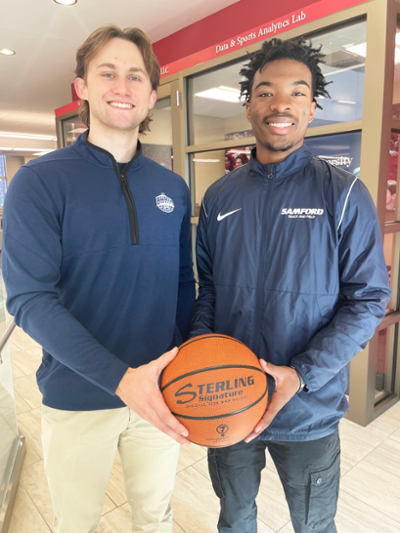Published on November 30, 2023 by Kevin Scarbinsky

AJ McInnis, Ian Jones
Those fun personal facts are not unique to a college athlete like Jones, but the Samford University junior is not your typical college athlete. His roundball playing days ended in high school. He competes for the Bulldogs as a triple and long jumper on the track team, not as a point or combo guard on the men's basketball team.
So how does he plan to make a career out of his favorite sport?
"My dream is definitely to be on a data analytics team, preferably for a basketball team, whether it's college or professional," Jones said.
That's why Jones took the leap from Fullerton, California, to Homewood, Alabama. At Samford, he is pursuing a finance degree with a data analytics concentration at Brock School of Business while gaining real-world professional experience through the Center for Sports Analytics.
The center's students work with college and professional teams in one of two general areas, according to Professor Darin White, the center's executive director: "Moneyball-type stuff" such as front-office and coaching strategy or "human performance," which includes collecting "a huge amount of data" on every Samford athlete when he or she goes into the weight room to maximize their production.
Jones may not play for men's basketball coach Bucky McMillan, but his work this semester could help McMillan's Bulldogs make the jump from sharing the Southern Conference regular-season championship, which they did last season, to winning it outright and earning the automatic bid to the NCAA Tournament that goes with it.
In collaboration with White, his faculty mentor, Jones is studying the momentum-changing hot streaks in basketball games known as runs. What factors cause positive runs that can spark a comeback or turn a close game into a runaway? What about negative runs that can spiral into a defeat?
Jones said he and White "crafted a template of how we collect data and how we analyze it." Jones breaks down the tape of every Samford non-conference game to isolate momentum runs and chart variables in about 50 different categories during those stretches. Personnel. Shot selection. Paint touches. Etc., etc., etc.
Before SoCon play begins, they will present their findings to McMillan, who has long been a believer in the value of analytics. Jones explained the value proposition of his project this way:
"What if we can analyze what causes these runs so we can almost manipulate a six-point-plus run or an eight-point-plus run?" Jones said. "I wanted to create a project that can help this basketball team."
Another Brock School of Business student is helping another basketball team for a second season. While studying to finish his undergraduate degree in the spring, senior AJ McInnis from Chattanooga, Tennessee, holds an actual staff position with the Birmingham Squadron of the G-League as an analytics analyst.
McInnis produces a postgame analytics report for every Squadron game modeled after the reports used by the team's NBA affiliate, the New Orleans Pelicans. He works with their analytics staff to understand the kind of data that will be useful for head coach TJ Saint, his assistants and the players.
For example, he charts the success rates of baseline and sideline out-of-bounds plays known as BLOBs and SLOBs. He also tracks how the Squadron compares to the rest of the G-League in a plethora of statistical categories.
Nathan Kirkpatrick, assistant professor of sports business, serves as the faculty mentor for McInnis. As a former college basketball coach and administrator himself, Kirkpatrick brings a first-person perspective to his mentorship.
"Coaches may not care how you're running statistical models," Kirkpatrick said. "They're trying to win a game."
McInnis said he appreciates Kirkpatrick's guidance, which has ranged from "helping me understand how to approach a coach" to "making sure I balance myself from work to college and also my spirituality. He's been a great help with all of those things."
Offering prospective students real-world experience guided by veteran mentors has been a winning strategy for Samford’s Center for Sports Analytics. It has attracted quality students from near and far such as McInnis from Tennessee and Jones from California and helped them create career opportunities after graduation.
Jones said he's learned a valuable core lesson at Samford. "Even if I'm not an athlete, I can impact the world of basketball."
McInnis was in the initial group of students admitted to the Center for Sports Analytics. He said his Samford experience "has 1,000 percent exceeded my expectations. I could have never imagined being in college and already being affiliated with a professional basketball team.
"If you want to work in sports, Samford is THE place to be."
Located in the Homewood suburb of Birmingham, Alabama, Samford is a leading Christian university offering undergraduate programs grounded in the liberal arts with an array of nationally recognized graduate and professional schools. Founded in 1841, Samford enrolls 6,324 students from 44 states, Puerto Rico and 16 countries in its 10 academic schools: arts, arts and sciences, business, divinity, education, health professions, law, nursing, pharmacy and public health. Samford is widely recognized as having one of the most beautiful campuses in America, featuring rolling hills, meticulously maintained grounds and Georgian-Colonial architecture. Samford fields 17 athletic teams that compete in the tradition-rich Southern Conference and boasts one of the highest scores in the nation for its 97% Graduation Success Rate among all NCAA Division I schools.

